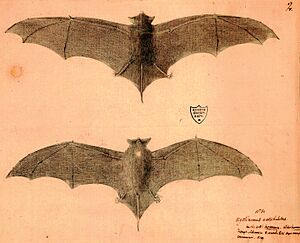Natal free-tailed bat facts for kids
Quick facts for kids Natal free-tailed bat |
|
|---|---|
 |
|
| Type illustration by Paul Jossigny from 1770 | |
| Conservation status | |
| Scientific classification | |
| Genus: |
Mormopterus
|
| Species: |
acetabulosus
|
| Synonyms | |
|
|
The Natal free-tailed bat (Mormopterus acetabulosus) is a small bat that belongs to the Molossidae family. These bats are special because they are only found on the island of Mauritius. They live in caves and are considered an endangered species. This means their numbers are very low and they are at risk of disappearing.
Contents
About Its Name and Family
This bat was first described as a new species in 1804 by a French scientist named Johann Hermann. He gave it the scientific name Vespertilio acetabulosus.
Later, in 2008, scientists looked closer at the Natal free-tailed bat. They decided that what they thought was one species was actually two! So, they split it into two different kinds of bats. One of these new bats was named Mormopterus francoismoutoui.
The name "Natal" comes from another bat that Hermann described, which was found in the Natal Province of South Africa. The second part of its scientific name, "acetabulosus", is a Latin word that means "saucer-shaped."
What Does It Look Like?
The Natal free-tailed bat is a very tiny bat. It has a wrinkled upper lip. Its ears are small and are connected at the back by a thin piece of skin.
Male Natal free-tailed bats have a special gland that produces an oily substance. This is similar to what some other free-tailed bats have.
This bat has a specific number of teeth, which scientists call a dental formula. It has 30 teeth in total.
Where Does It Live?
This bat is mostly found only on the island of Mauritius. This means it is endemic to Mauritius, which means it naturally lives there and nowhere else.
There have been a few possible sightings in other places, like Madagascar and South Africa. However, scientists think these might just be bats that got lost and flew far from their usual home. These lost animals are called vagrants.
Why Is It Endangered?
Since 2017, the Natal free-tailed bat has been listed as endangered by the IUCN. The IUCN is a group that keeps track of how many animals are left in the world.
From 1999 to 2017, the number of these bats dropped by more than 80%. This is a very big decrease! One of the main reasons for this decline is that their cave homes are being disturbed. Sometimes, people visiting the caves for tourism can accidentally bother the bats, which makes it hard for them to live and raise their young.


